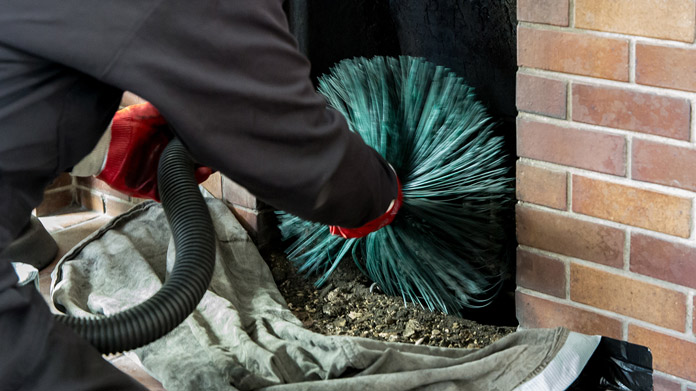Important Chimney Maintenance San Jose Tips Every House Owner Must Know
Important Chimney Maintenance San Jose Tips Every House Owner Must Know
Blog Article
Expert Tips for Effective Chimney Maintenance You Need to Know
Smokeshafts work as critical elements in lots of homes, providing heat and comfort. Guaranteeing their correct upkeep is frequently forgotten until concerns occur. Comprehending the intricacies of smokeshaft care can be the secret to avoid costly repairs and protecting your home and family. From the importance of regular assessments to safe operational methods, an extensive technique to smokeshaft upkeep is crucial. Allow's explore professional suggestions that can help you maintain your chimney in ideal condition for many years to come.
Value of Regular Evaluations
Regular examinations of smokeshafts are important for guaranteeing their safety and functionality. Smokeshafts play an important role in venting out dangerous gases and keeping appropriate air movement in a home. Gradually, creosote accumulation, debris, and architectural damage can take place within the smokeshaft, positioning significant risks such as smokeshaft fires or carbon monoxide gas leaks.
Throughout a chimney examination, trained experts analyze the condition of the smokeshaft, seeking any type of signs of damages, clogs, or degeneration. They likewise check the honesty of the flue, chimney liner, and chimney cap to ensure everything is in correct working order. By identifying and dealing with issues early on, potential dangers or costly fixings can be stayed clear of.
Routine evaluations not only help in preserving the security of the smokeshaft yet likewise add to its overall efficiency. A well-kept and clean smokeshaft runs extra successfully, guaranteeing appropriate ventilation and lowering the risk of interior air contamination. Consequently, organizing yearly chimney assessments is a positive procedure that home owners can require to safeguard their property and enjoyed ones.
Cleansing Methods and Frequency
Preserving the security and efficiency of a smokeshaft entails not just normal examinations however likewise carrying out ideal cleansing methods and identifying the ideal regularity for cleansing. Smokeshafts need to be cleansed by an expert chimney sweeper a minimum of annually, also if they are not often used. However, if the smokeshaft is utilized regularly, specifically with wood-burning ovens or fireplaces, it may need even more regular cleanings to stop the build-up of creosote, a highly combustible compound that can bring about chimney fires.
Home owners need to never ever neglect chimney cleansing, as it is crucial for keeping a functional and secure chimney system. Normal cleanings not only lower the risk of chimney fires but also enhance the smokeshaft's total performance and longevity.
Attending To Smokeshaft Leaks

When dealing with smokeshaft leaks, comprehensive inspection and timely repair services are vital to avoid water damages and preserve the architectural integrity of the smokeshaft. Leakages in a chimney can result in significant problems such as mold and mildew development, wear and tear of the smokeshaft structure, and even possible fire dangers. To effectively resolve chimney leakages, start by inspecting the chimney cap, crown, blinking, and masonry for any signs of damage or wear. Smokeshaft caps need to be securely in position to protect against water from entering, while the crown and flashing must be undamaged and appropriately sealed. Any fractures or voids in the masonry must be repaired quickly to avoid water seepage. Additionally, take into consideration waterproofing the chimney to offer an additional layer of defense against wetness. Regular upkeep and inspections can help deal with and find smokeshaft leakages early, conserving you from costly repair work and making sure the safety and long life of your chimney.
Recognizing Creosote Accumulation
To comprehend the potential risks of creosote build-up in smokeshafts, it is vital to identify its development procedure and effect on chimney efficiency. Creosote is a black or brownish tar-like substance that accumulates inside smokeshaft systems when wood or fossil gas are melted. As smoke increases via the Discover More smokeshaft, it condenses and cools, bring about the formation of creosote, which adheres to the chimney walls.
:max_bytes(150000):strip_icc()/SPR-cleaning-your-chimney-4165660-hero-01-4d934e9941a04d46bba9be40ff52d5f9.jpg)
Routine chimney assessments and cleansings by a specialist chimney sweeper are important in stopping creosote build-up and guaranteeing the risk-free procedure of your chimney system.
Safe Procedure Practices
Carrying out proper security methods is crucial for the effective and safe operation of smokeshaft systems. Always make certain that the chimney is skillfully inspected and cleansed regularly to remove any type of creosote build-up, which can lead to smokeshaft fires.
In addition, see to it to just burn experienced wood in your fireplace, as wet or eco-friendly timber can generate even more creosote and trigger hazardous smokeshaft clogs. Lastly, never leave a fire neglected and constantly make sure the fire is completely extinguished prior to going to bed or leaving your house. By adhering to these secure procedure practices, you can take pleasure in a relaxing and cozy fire while ensuring the safety of your home and loved ones.
Conclusion
In verdict, preserving your chimney is important for guaranteeing its security and efficiency. Normal assessments, proper cleansing techniques, resolving leakages, handling creosote accumulation, and complying with secure operation techniques are crucial elements of smokeshaft maintenance.
Over time, creosote accumulation, particles, and architectural damage can take place within the smokeshaft, posturing significant risks such as smokeshaft fires or carbon monoxide leakages.
If the chimney is utilized routinely, particularly with wood-burning ranges or fire places, it might require even more regular cleansings to prevent the accumulation of creosote, an extremely combustible material that can lead to chimney fires. (Chimney Maintenance San Jose)
To understand the prospective threats of creosote build-up in smokeshafts, it is vital to identify its development process and effect on chimney performance. As smoke climbs via the chimney, it cools and condenses, leading to the development of creosote, which adheres to the chimney walls.
Constantly make certain that the smokeshaft is skillfully inspected visit our website and cleaned click here for more info up consistently to get rid of any creosote accumulation, which can lead to chimney fires.
Report this page